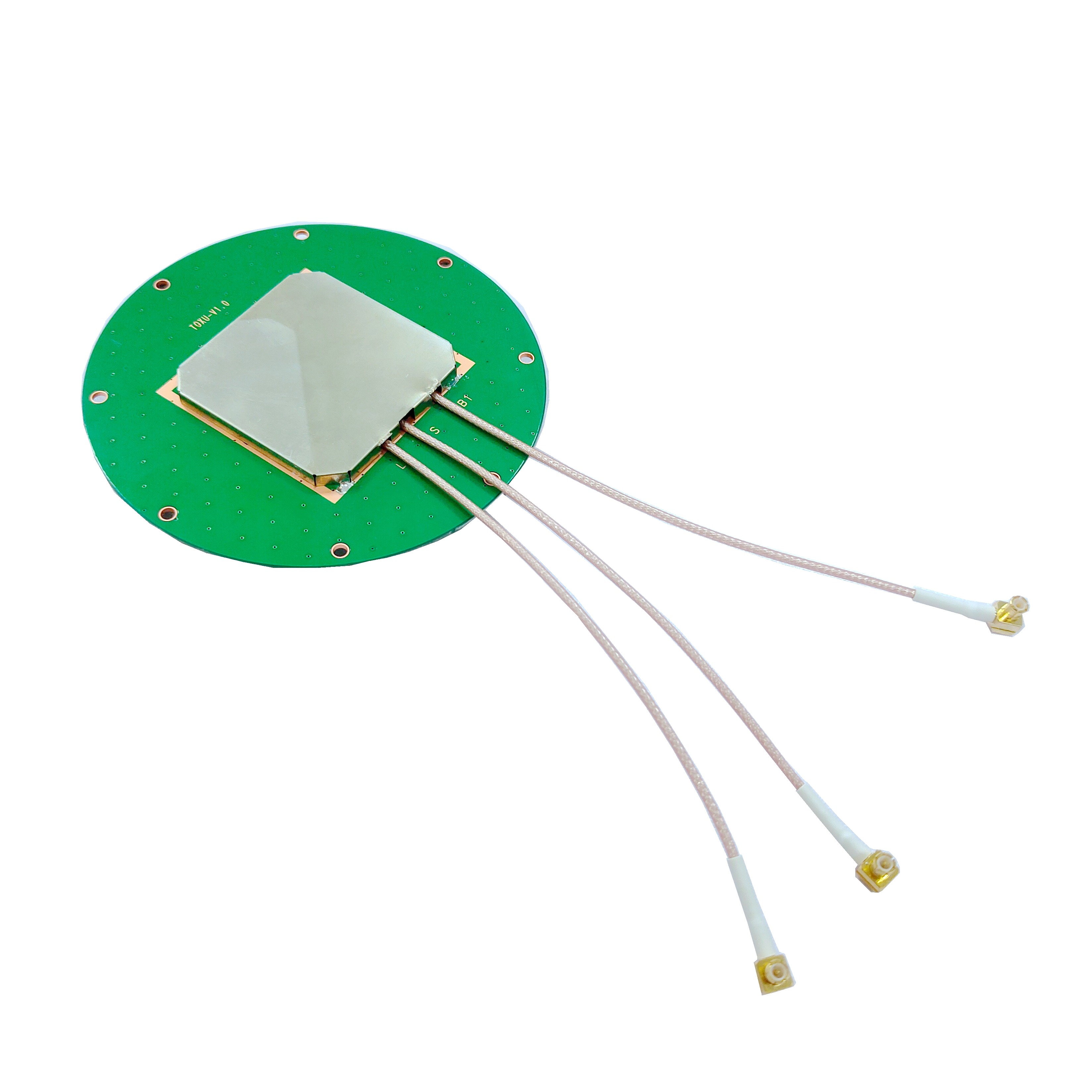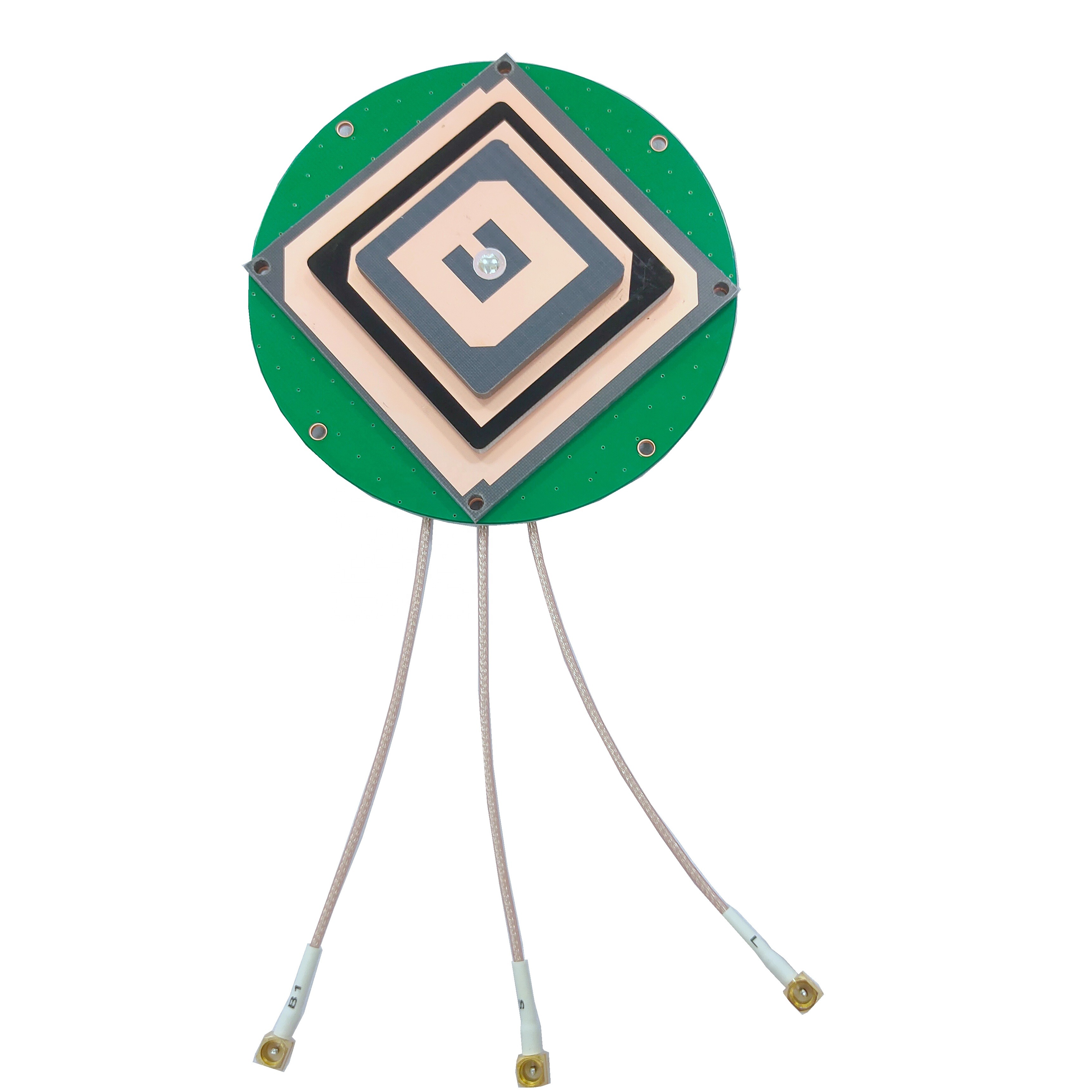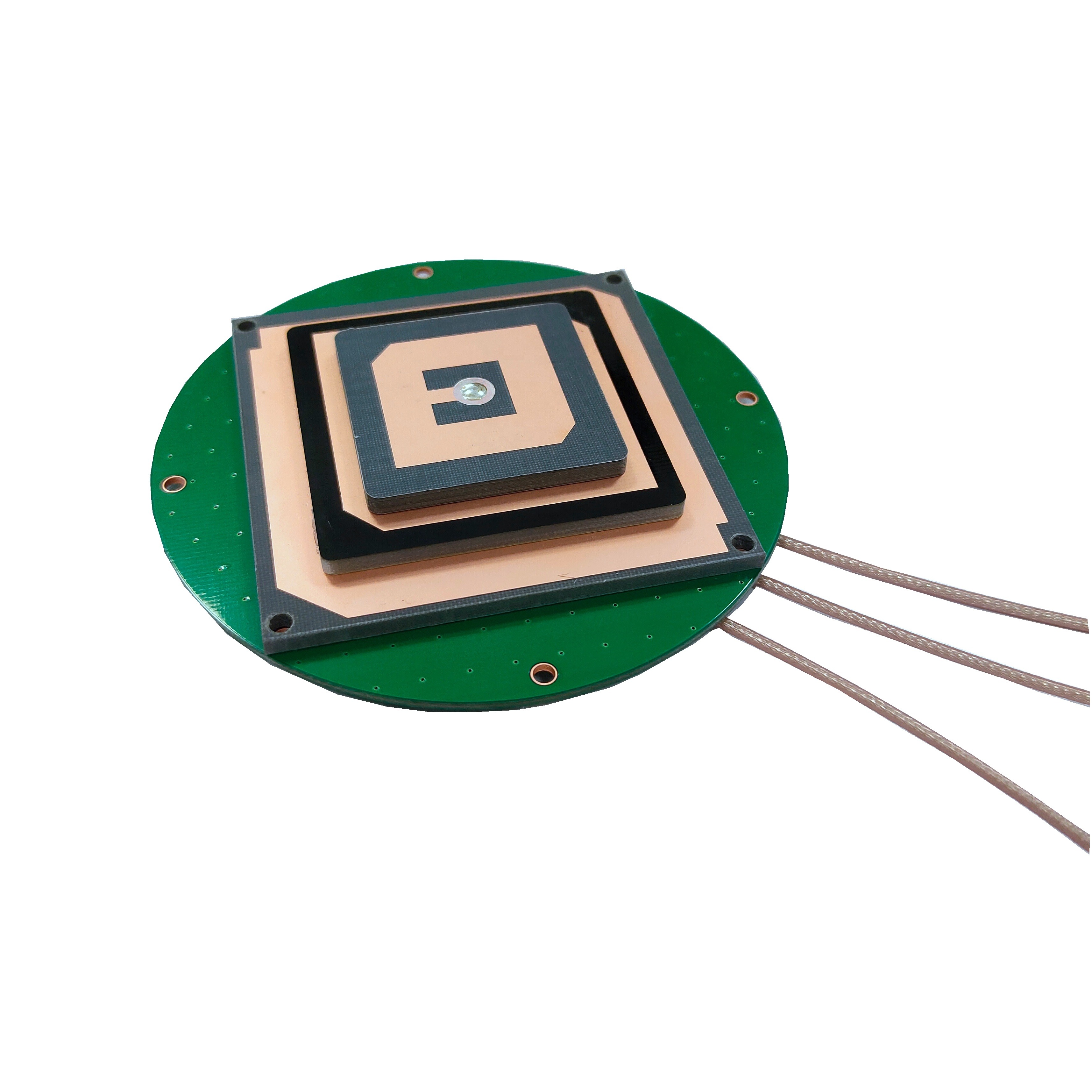Overview
This gap between meter-level and centimeter-level accuracy is bridged by a sophisticated technique known as Real-Time Kinematic (RTK) positioning. RTK is a differential GNSS (DGNSS) method that uses a fixed base station and a mobile rover unit. The base station, with its precisely known coordinates, calculates the error in the satellite signals it receives and transmits this error correction data to the rover. The rover then uses this data to correct its own satellite measurements in real-time, achieving positional accuracy within 1-2 centimeters. The heart of any RTK system, especially on the rover side, is its antenna. The recent and critical innovation in this field is the development of the miniature embedded RTK GNSS antenna.
A miniature embedded RTK GNSS antenna is not just a scaled-down version of a traditional survey-grade antenna. It is a highly specialized, multi-component module designed to be integrated directly into a host device—a drone, a robot, an agricultural implement, or an industrial tool—rather than being an external, bulky accessory. This "embedding" signifies a shift from a system component to an integral, almost invisible, part of the product's design. Its miniaturization is a feat of engineering that balances the conflicting demands of physical size, electrical performance, robustness, and cost.
The driving force behind this miniaturization is the explosion of autonomous and semi-autonomous systems across various industries. A self-driving lawnmower, a delivery drone, a robotic arm in a smart factory, or an asset tracker all require highly precise, reliable, and continuous positioning data to function correctly. They cannot rely on large, externally mounted antennas that are prone to damage, add weight and wind resistance, and compromise the product's design aesthetics and usability. The miniature embedded antenna solves these problems by offering a low-profile, ruggedized solution that delivers the high-performance signal integrity essential for RTK calculations.
In essence, the miniature embedded RTK GNSS antenna is the critical sensory organ that allows machines to perceive their absolute position on Earth with unprecedented accuracy. It is a key enabler of the autonomy revolution, transforming how machines interact with and navigate their environment. Its development represents a convergence of advancements in materials science, microwave engineering, semiconductor technology, and signal processing, packaged into a form factor that was unimaginable just a decade ago.
Design and Construction
The design and construction of a miniature embedded RTK GNSS antenna are extraordinarily complex, involving a meticulous balance of electromagnetic performance, physical durability, and thermal management. Unlike a standard patch antenna, an RTK-grade antenna must exhibit exceptional characteristics to support the precision required for centimeter-level positioning.
1. Radiating Element and Patch Design:
The core of the antenna is typically a patch element, often square or circular, etched onto a dielectric substrate. For miniature antennas, this patch is carefully designed to operate across multiple GNSS frequency bands (e.g., L1, L2, L5 for GPS; E1, E5a, E5b for Galileo). This multi-band operation is non-negotiable for RTK, as it allows the receiver to perform sophisticated error correction by comparing signals on different frequencies (e.g., ionospheric delay correction). The shape, size, and feed point of the patch are optimized using electromagnetic simulation software to achieve a wide bandwidth, good impedance matching (typically 50 ohms), and the desired radiation pattern.
2. Ground Plane:
The performance of a patch antenna is heavily dependent on its ground plane. A finite or poorly designed ground plane can lead to a distorted radiation pattern, reduced gain, and a shifted phase center. The phase center is perhaps the most critical concept for an RTK antenna. It is the virtual point from which the radiation appears to emanate, and for RTK to work, this point must be stable and consistent across all angles and frequencies. Any movement of the phase center introduces error into the measurement. High-end embedded antennas often incorporate a dedicated, robust ground plane within their assembly to isolate performance from the host printed circuit board (PCB), which may have noisy components or an irregular shape.
3. Dielectric Materials:
The substrate material between the radiating patch and the ground plane is crucial. For miniaturization, engineers use materials with a high dielectric constant (εr). This allows the physical size of the patch to be smaller, as the wavelength within the material is reduced. However, high-dielectric materials often come with trade-offs like reduced bandwidth and lower efficiency. Advanced ceramic substrates or specialized laminates like Rogers RO4000 series are commonly used to strike the right balance between size, bandwidth, and thermal stability.
4. Feeding Techniques:
The method of delivering the RF signal from the patch to the receiver is vital. Common techniques include coaxial probe feeding and aperture-coupled feeding. Aperture coupling, where the patch is electromagnetically coupled to a feed line beneath the ground plane through a slot, is often preferred in high-performance designs. It provides good isolation, broader bandwidth, and helps in achieving a symmetrical radiation pattern with a stable phase center.
5. Anti-Jamming and Filtering (CRPA-ready designs):
Some advanced miniature antennas are designed to be elements in a Controlled Reception Pattern Antenna (CRPA) array. A CRPA system uses multiple antenna elements (e.g., 4 or 7) and sophisticated electronics to actively nullify interfering or jamming signals. While the antenna itself may be passive, its design must be compatible with being part of such an array, requiring precise knowledge of the phase and amplitude response of each element.
6. Housing and Environmental Protection:
The antenna is encapsulated in a radome—a protective housing that is transparent to RF signals. The material (often plastic or ceramic) and shape of the radome are carefully designed to minimize signal attenuation and phase distortion. The entire assembly is then potted or sealed to provide resistance against environmental factors like water (IP67 rating is common), dust, salt spray, UV radiation, and extreme temperatures. Mechanical robustness to withstand vibration and shock is also a key design consideration for embedded applications in vehicles and robots.
Working Principles
The working principle of a miniature embedded RTK GNSS antenna can be dissected into two main aspects: its function as an electromagnetic transducer and its role within the larger RTK ecosystem.
As an Electromagnetic Transducer:
At its most fundamental level, the antenna's job is to convert the electromagnetic energy of incoming GNSS radio waves into an electrical current that can be processed by the receiver. GNSS signals are incredibly weak by the time they travel over 20,000 kilometers from the medium Earth orbit satellites to the Earth's surface. They are often described as being "below the noise floor," meaning their power is lower than the inherent background radio noise. Therefore, the antenna must be highly efficient at capturing this faint energy.
The antenna is designed to be sensitive to right-hand circularly polarized (RHCP) signals, as this is the polarization used by all major GNSS constellations. It rejects left-hand circularly polarized (LHCP) signals, which are often reflections (multipath) of the original signal off buildings, the ground, or other objects. By rejecting multipath, the antenna improves the quality of the signal data before it even reaches the receiver. The antenna's radiation pattern is intentionally designed to be hemispherical, providing a wide view of the sky to track as many satellites as possible, even when the host device is tilting or moving dynamically.
Within the RTK Ecosystem:
The antenna's performance is the foundational first step in the RTK chain. The precision of RTK stems from measuring the carrier phase of the GNSS signal, not just the code. The carrier phase measurement is far more precise but is inherently ambiguous—the receiver knows the phase of the wave but not how many full wavelengths exist between the satellite and itself. This is the "integer ambiguity" problem.
The role of the antenna is critical here because any instability in its phase center will directly inject error into this delicate carrier phase measurement. Imagine the phase center as the "measuring point" of the antenna. If this point moves even a millimeter due to changes in the signal's angle of arrival, temperature, or frequency, the measured carrier phase will change by a corresponding amount, introducing a centimeter-level error. Therefore, a high-quality RTK antenna is characterized by an extremely stable and well-defined phase center that is consistent across all frequencies and angles. Calibration data provided by the manufacturer maps the phase center variations (PCV) so the receiver's firmware can correct for them.
The antenna feeds the amplified signal to the RTK GNSS receiver module. The receiver correlates the signals, acquires the satellite codes, and, most importantly, extracts the precise carrier phase measurements. It simultaneously receives correction data from the base station via a cellular, radio, or satellite link. Using sophisticated algorithms, it resolves the integer ambiguities and calculates its precise position relative to the base station, achieving centimeter-level accuracy. The entire process happens in real-time, often at update rates of 10-20 Hz, providing a continuous, high-precision position stream to the host system for navigation and control.
Advantages and Challenges
-
Advantages:
High Precision in a Small Form Factor: The primary advantage is the ability to deliver survey-grade, centimeter-level accuracy from a module that can be integrated seamlessly into compact devices, enabling new applications in autonomy and robotics.
Improved Product Design and Aesthetics: Manufacturers can design sleek, integrated products without protruding antennas, improving aesthetics, aerodynamic performance (for drones), and usability.
Enhanced Robustness and Reliability: Being embedded and potted, these antennas are protected from physical damage, moisture, dust, and corrosion, leading to higher long-term reliability in harsh environments.
Reduced Multipath and Interference: Advanced design techniques, including ground plane isolation and high-quality materials, result in better rejection of signal reflections (multipath) and RF interference compared to simple, off-the-shelf patch antennas.
Simplified System Integration: These modules often come as a complete solution (antenna + pre-amplifier) with standardized connectors and mounting options, reducing the RF design expertise required by the OEM and speeding up time-to-market.
Challenges:
Performance vs. Size Trade-off: The fundamental challenge is physics. A smaller antenna has a smaller aperture, which can limit its gain and efficiency. Designers must constantly trade off size against bandwidth, efficiency, and phase center stability.
Thermal Management: The low-noise amplifier (LNA) embedded within the antenna assembly generates heat. In a small, sealed package, dissipating this heat is challenging. Temperature changes can cause material expansion and contraction, potentially shifting the electrical characteristics and the phase center. Advanced materials with low thermal coefficients are required to mitigate this.
Host Device Interaction: When embedded, the antenna's performance can be affected by its proximity to other components on the host PCB. Metals, batteries, and displays can detune the antenna, block the signal, or become part of the radiating system, distorting the radiation pattern. Careful placement and isolation are critical.
Cost: High-performance materials (specialized ceramics, laminates), precise manufacturing tolerances, and individual calibration for phase center variation make these antennas significantly more expensive than standard GNSS antennas.
Calibration Complexity: Providing accurate phase center variation (PCV) calibration data for the antenna across all supported frequencies and elevation angles is a complex and costly process, but it is essential for achieving the highest accuracy.
Applications and Future Trends
-
Applications:
Precision Agriculture: Autonomous tractors and harvesters use embedded RTK antennas to follow pre-program paths with centimeter accuracy, minimizing overlap and gaps for efficient seeding, spraying, and harvesting.
Unmanned Aerial Vehicles (UAVs)/Drones: Used for aerial surveying, mapping, LiDAR scanning, and precision delivery. The antenna enables accurate flight paths, stable hovering, and precise landing, even in challenging environments.
Robotics: Autonomous mobile robots (AMRs) in warehouses, logistics centers, and factories rely on them for navigation. Outdoor robots for security, cleaning, and landscaping also depend on this technology.
Autonomous Vehicles and ADAS: While full autonomy uses sensor fusion, embedded RTK GNSS provides the absolute global position and heading crucial for localization layers in self-driving cars and advanced driver-assistance systems.
Industrial Machinery: Grade control and machine guidance in construction (e.g., bulldozers, excavators) use embedded antennas to accurately move earth according to a digital design model.
Marine and Aquatic Applications: Autonomous surface vessels (ASVs) and underwater drones (which surface for positioning) use them for precise navigation and data geotagging.
Future Trends:
Further Miniaturization: The relentless drive for smaller, more discrete devices will push antenna sizes even smaller, likely leveraging new metamaterials and 3D printing techniques.
Tighter Integration (Antenna-in-Package): The next step is to integrate the antenna directly with the GNSS receiver chip into a single System-in-Package (SiP) or Module-on-Chip (MoC), reducing the entire RTK positioning engine to a single, tiny component.
AI-Enhanced Antennas: Integration of basic processing at the antenna level could use AI algorithms to dynamically characterize and mitigate multipath and jamming in real-time, adapting the antenna's response to its environment.
Multi-Function Antennas: A single embedded module will combine GNSS with other wireless services like 5G for correction data, Wi-Fi, Bluetooth, and UWB for indoor-outdoor positioning handover.
Resilient PNT: Future designs will increasingly focus on anti-jamming (AJ) and anti-spoofing capabilities as standard features, making systems more resilient in contested or unreliable signal environments.
Conclusion
The miniature embedded RTK GNSS antenna is a transformative technology that has democratized centimeter-accurate positioning. It is a masterpiece of engineering that overcomes significant physical and electrical challenges to pack high performance into a robust, low-profile package. By moving from an external accessory to an embedded component, it has become a key enabler for the next wave of automation and autonomy across diverse industries, from agriculture and construction to robotics and transportation.
Its development is a testament to the continuous innovation in the field of RF and microwave engineering, where advances in materials, simulation software, and manufacturing processes have converged. While challenges remain in balancing the ever-present trade-offs between size, performance, and cost, the trajectory is clear: these antennas will become smaller, smarter, more integrated, and more resilient. As the demand for precise machine location continues to grow, the miniature embedded RTK GNSS antenna will remain an indispensable and increasingly sophisticated component at the heart of the autonomous systems shaping our future. It is not merely a receiver of signals but a fundamental pillar upon which the precise navigation of intelligent machines is built.




































































 Language
Language
 En
En Cn
Cn Korean
Korean

 Home >
Home > 







 18665803017 (Macro)
18665803017 (Macro)













